Coffee training Coffee Cup testing basic process knowledge
The cup testing procedure is a way used by cup testers to judge the flavor characteristics of coffee. In order to understand the differences in the flavor of coffee beans in each producing area, it is necessary to put each coffee bean together. Usually, the cup test can also find out the defects in the flavor of a bean, and a new mixed bean formula can also be developed through the cup test report.
Desktop equipment preparation
1. During cup testing, 6-10 cups are usually prepared for a bean and arranged into a triangle.
two。 Place the raw beans of the coffee beans and freshly roasted samples of cooked beans at the top of the triangle.
3. Put two cups in the middle of the table, one cup with water similar to room temperature, and the other cup with several spoons for testing.
4. Personally, it is strongly recommended that before the cup test process is finished (including smelling dry and wet aroma, sipping soup to analyze flavor characteristics), cover the raw and cooked bean samples, wait until the cup test is completed, and then open it, and make the final evaluation according to the appearance. This program can avoid the lack of "visual impression".
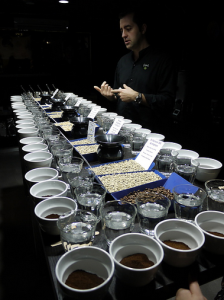
Sample preparation
1. Each cup contains two teaspoons of powder. it must be freshly roasted and freshly ground coffee powder. the special cup is 6 ounces.
two。 The cooking concentration is based on the amount of 55 grams of 1000cc powder.
3. The grinding scale is similar to the fineness of French pressed and follicular coffee.
4. The roasting degree of coffee beans must be very shallow, and the time point is about 30 seconds after the first explosion, which is far away from the second explosion. Under this baking degree, it is easier for us to distinguish the flavor defects, sweetness and aroma of a bean after deep baking. The baking degree of each cup test sample bean must be almost the same, which can be observed by the powder chromaticity of each sample bean after grinding, but it must be compared on black paper.
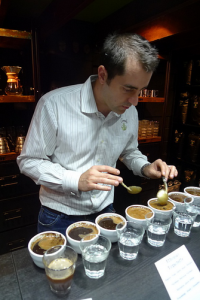
Dry and wet aroma analysis
1. Heat the filtered water on one side and smell the dry aroma of coffee powder on the other. The smell smelled before the injection of hot water is called dry aroma.
two。 Fill the cup with nearly boiling hot water, while pouring some hot water into the cup containing the spoon to preheat the spoon.
3. Without removing the powder layer, smell the wet aroma in the cup and record your first impression of the wet aroma.
4. After standing for 1-2 minutes, remove the powder layer with a preheated spoon, nose close to the cup and smell directly. At this time, the smell is the main smell of the wet aroma, then stir the coffee powder above and press it to the bottom of the cup as much as possible. Remember: the wet aroma must be scored and recorded before the coffee powder is stirred.
5. Wash the spoon with hot water before trying a new sample bean. When you grade the wet aroma of all the samples, scoop out the coffee powder particles that are still suspended in the cup with a spoon, but because the coffee is so lightly roasted, most of the coffee powder will sink to the bottom of the cup.
Flavor characteristic analysis:
When the coffee soup is almost cooled, scoop some coffee soup with a spoon and vigorously sip it so that it is sprayed on the surface of the tongue. The action of "sipping vigorously" is a very important way to evaluate coffee. Because this action can make the whole tongue surface evenly covered by the soup spray, in addition, this action can also make part of the juice deep into the throat and nasal cavity. Make the nasal cavity also become an important evaluation organ. The fact that most of the flavor of coffee comes from aromatic compounds can be proved by an experiment: you can hold your nose while drinking coffee, and when your nose is blocked, this cup of coffee tastes like instant coffee because of the lack of aroma components; when the nasal cavity is reopened, it will be willow and flowers, which can be proved by this.
After you write down your evaluation of flavor, acidity, aftertaste and viscosity, replace a bean and try to compare the similarities and differences between different beans. Usually after the coffee is cooled, the human tongue can always detect more flavor, so when doing a cup test, measure it at a mild temperature, and then test it again when it is cooled to room temperature. The beans with the best nature will have very good flavor characteristics in both stages.
If you have to test more than two beans at a time, it is recommended that you spit out the coffee in your mouth after each evaluation. If you swallow every mouthful of coffee, too much caffeine will have a great impact on your taste sensitivity.
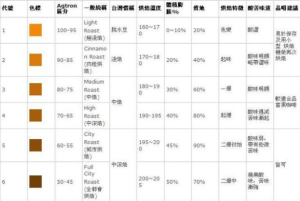
Conclusion:
Cup testing is all about constant practice and humility. The best cup testers I have ever met are usually curious. I have many opportunities to compare cup tests with internationally renowned cup testers, and sometimes I have different opinions. The beauty of this is that we all agree that it is normal for us to disagree with each other. We also respect the different tastes that other testers find in the same bean, and we all try to feel whether we can drink it.
Don't be frightened when you hear some very abstract taste adjectives. Cup testers usually use these abstract words to give coffee a romantic beauty, not just a description of flavor facts. The cup test program should be very interesting and fun, not compared to who speaks more accurately. But on the other hand, the adjectives you use must also describe the smell aptly, not just led by some textbooks.
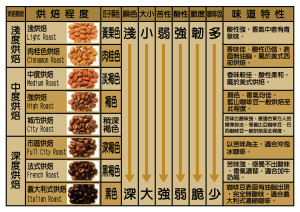
Although there are many strict and scientific rules to follow, the way is really used in the industry is not the same, almost every good cup tester has its own set of cup testing standards. You can do the cup test according to the conditions you like, but if you have to do the cup test with others, please don't deviate too much from this cup test.
The key to being a good tester is easy: practice constantly and have a little confidence in yourself, and most importantly, have a humble heart and always have a learning attitude.
Basic conditions of cup measuring room
The condition of the cup test room is very important for the cup test procedure and has an important influence on the cup test results. The following are the basic conditions of the cup testing room:
1. With natural light. Dark space has a great influence on human olfactory sensitivity.
two。 The room temperature should be kept between 20 and 25 degrees Celsius.
3. Indoor humidity should be controlled between 50% and 70%. If the humidity is too low, it will also affect human olfactory acuity.
4. The surrounding environment of the cup test room should be very quiet, and conversation is strictly prohibited during the cup test.
5. The best time for a cup test is between 10 and 12:00 (without lunch) and between 4 and 6 p.m. (without dinner), because during this time, the food in the previous meal has been digested, but not very hungry.
6. Lack of concentration can also have a great impact on cup test results, which can be caused by illness, lack of sleep or excessive psychological stress.
7. At least six cups should be prepared for each sample bean, arranged in a triangular shape, with 1 cup at the top, 2 cups in the second row, and 3 cups in the third row.
8. The samples of raw beans and cooked beans of the beans are placed above the triangle, and the two samples can be covered while the cup test is carried out.
9. There should be several cups with hot water on the tester table for cleaning spoons; other cups should be filled with 1 cup of boiled water about 3 cups of room temperature and 2 cups of hot water for the tester to clean the residual taste in the mouth.
Important Notice :
前街咖啡 FrontStreet Coffee has moved to new addredd:
FrontStreet Coffee Address: 315,Donghua East Road,GuangZhou
Tel:020 38364473
- Prev
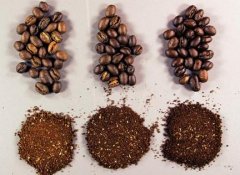
Fine Coffee Bean Technology coffee Grinding process
(1) the principle of grinding, generally speaking, a good grinding method should include the following four basic principles: 1, the degree of grinding suitable for cooking method should be selected; 2, the temperature of cattle produced during grinding should be low; 3, the powder should be uniform after grinding; 4, it should be ground before cooking. No matter what kind of grinder is used, it is bound to generate heat by friction in operation. Most of the excellent substances are highly volatile.
- Next
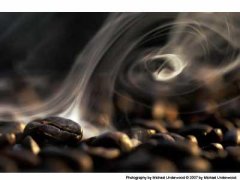
Fancy coffee making method of iced coffee
Make your iced coffee more lively and sweeter. Blue Bottle created a New Orleans iced coffee. Combine silky ice brew, baked chicory, whole milk and sugar to bring you into the French neighborhood (French Quarter, the oldest neighborhood in New Orleans). Blue Bottle's drink was such a success that they now put it in milk cartons as a follow-up.
Related
- What is the meaning of lactic acid fermentation with coffee bean treatment?
- How to judge the state of foam by sound?
- How does the latte pull out the unicorn pattern? Come to get for a little trick to improve the flower pull!
- Will flower pulling affect the taste of the latte?
- Do you know the history of coffee?
- The difference between honey treatment and sun washing what is raisin honey treatment?
- What kind of milk can a novice use to make coffee foam to keep the foam longer? The correct method and skills of milking tutorial sharing
- Why do washed coffee beans taste sour? Flavor characteristics of washed Coffee
- Introduction to the skill of how to practice the size and height of water injection around the circle of hand-brewed coffee
- How do beginners practice coffee flower drawing from scratch?

